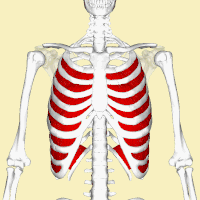Intercostal muscle
The intercostal muscles (intercostales interni) are a group of skeletal muscles between the ribs.[1] These muscles help expand and shrink the size of the chest cavity to help breathing.

Internal intercostal muscles (shown in red)
When breathing in, the muscles of the diaphragm contract. This pulls the diaphragm downwards, and increases the volume of the thorax. At the same time, the external intercostal muscles contract. This pulls the ribcage upwards and outwards. This also increases the volume of the thorax.
There are three main layers;
- External intercostal muscles help inhalation. They pull up the ribs and bend them more open. This expands the thoracic cavity.
- Internal intercostal muscles help in forced breathing out (quiet expiration is a passive process). They depress the ribs and bend them inward. This decreases the width of the thoracic cavity.
- Innermost intercostal muscle reduces thorax volume, so are also expiratory muscles.
References
Wikimedia Commons has media related to Internal intercostal muscles.
- "BodyMaps; Intercostal muscles". Healthline Networks, Inc. Retrieved 12 March 2015.
This article is issued from Wikipedia. The text is licensed under Creative Commons - Attribution - Sharealike. Additional terms may apply for the media files.